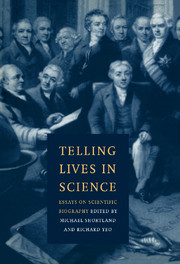Book contents
- Frontmatter
- Contents
- List of contributors
- Preface
- Introduction
- 1 Existential projects and existential choice in science: science biography as an edifying genre
- 2 Life-paths: autobiography, science and the French Revolution
- 3 From science to wisdom: Humphry Davy's life
- 4 Robert Boyle and the dilemma of biography in the age of the Scientific Revolution
- 5 Alphabetical lives: scientific biography in historical dictionaries and encyclopaedias
- 6 The scientist as hero: public images of Michael Faraday
- 7 ‘Tactful organising and executive power’: biographies of Florence Nightingale for girls
- 8 Taking histories, medical lives: Thomas Beddoes and biography
- 9 The scientist as patron and patriotic symbol: the changing reputation of Sir Joseph Banks
- 10 Metabiographical reflections on Charles Darwin
- Index
7 - ‘Tactful organising and executive power’: biographies of Florence Nightingale for girls
Published online by Cambridge University Press: 28 October 2009
- Frontmatter
- Contents
- List of contributors
- Preface
- Introduction
- 1 Existential projects and existential choice in science: science biography as an edifying genre
- 2 Life-paths: autobiography, science and the French Revolution
- 3 From science to wisdom: Humphry Davy's life
- 4 Robert Boyle and the dilemma of biography in the age of the Scientific Revolution
- 5 Alphabetical lives: scientific biography in historical dictionaries and encyclopaedias
- 6 The scientist as hero: public images of Michael Faraday
- 7 ‘Tactful organising and executive power’: biographies of Florence Nightingale for girls
- 8 Taking histories, medical lives: Thomas Beddoes and biography
- 9 The scientist as patron and patriotic symbol: the changing reputation of Sir Joseph Banks
- 10 Metabiographical reflections on Charles Darwin
- Index
Summary
Feminist historians have thoroughly documented the unequal struggle of women who wished to enter the scientific professions, from the very beginnings of modern scientific enquiry in Europe. As long as science remained an amateur occupation of doubtful economic security and without a career structure and public rewards, isolated women from the upper classes – often related to a well-known pioneering scientist – made independent contributions as scientists. But in the nineteenth century matters changed swiftly; while science might still be a hard taskmaster, it brought rewards to many men. Biographies abound of poor boys who found fame as scientists: Michael Faraday, Louis Pasteur, Jean Henri Fabre and others. By the late nineteenth century books aimed at aspiring young scientists appear with titles such as The Romance of Medicine, Microbe Hunters, Famous Men of Science or Heroes of Modern Progress. Women were conspicuously absent in these narratives of scientific adventure. But they did not disappear altogether, either in scientific work itself or in the many biographies for girls. These tokens – Caroline Herschel, Mary Somerville, Marie Curie – were eulogised as much for their feminine qualities as their achievements. Ironically, the women who had fought hardest for access to specialised knowledge for the public good – medical women – were rarely mentioned in nineteenth-century biographies.
An examination of the values promoted in these biographies for adolescent girls may help to explain why so few considered a career in science at the very time when it became possible.
- Type
- Chapter
- Information
- Telling Lives in ScienceEssays on Scientific Biography, pp. 195 - 214Publisher: Cambridge University PressPrint publication year: 1996
- 3
- Cited by

